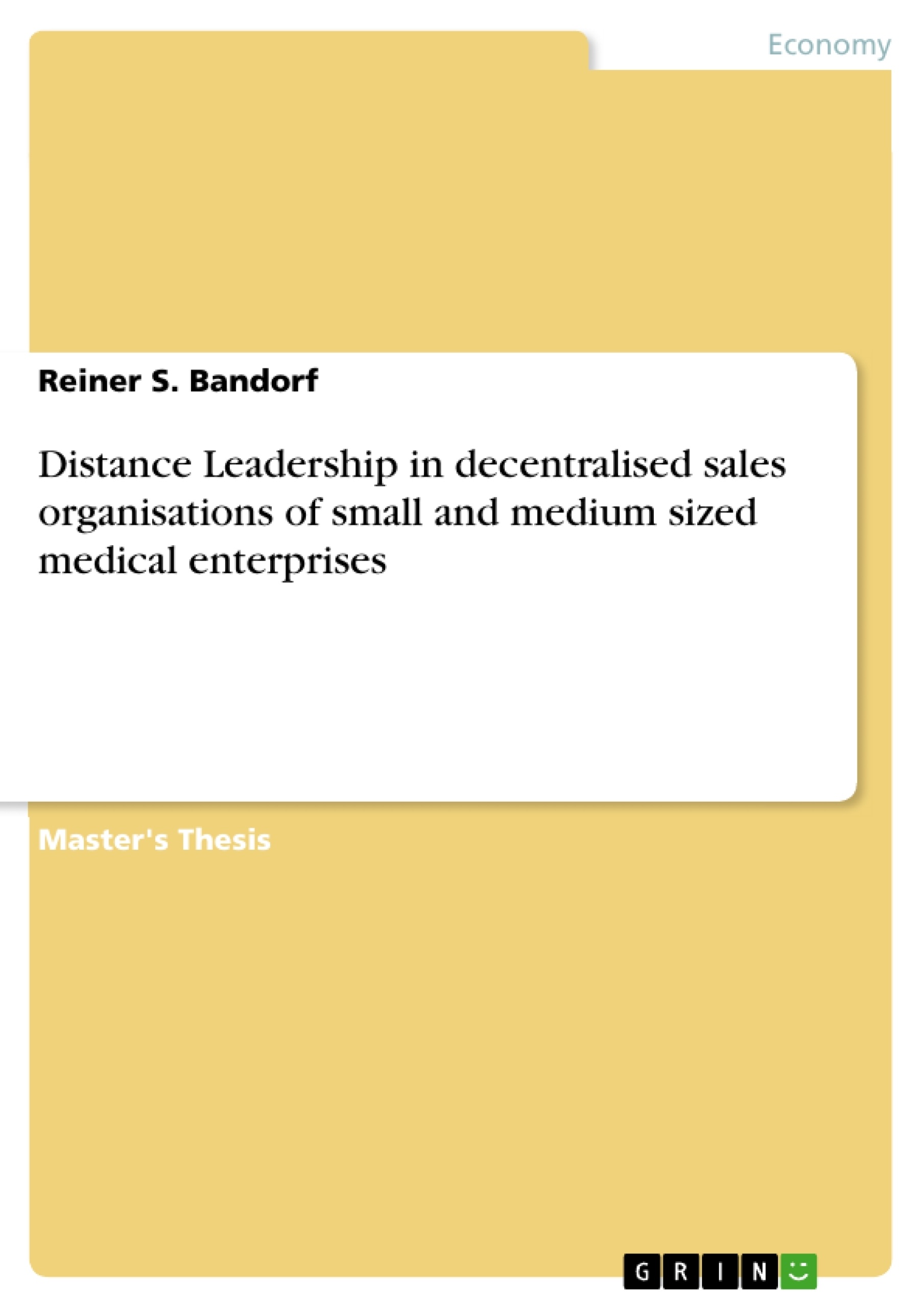This master thesis analyses the theoretical basis for Distance Leadership. It examines how decentralised structures affect specifically in the area of personnel management of sales organisations which organisational and communication management tools prove to be useful in this situation and lead to the choice thereof is applied in small and medium-sized companies (KMU). The objective of this work is to gain an overview of the state of research on the topic of Leadership and Distance to substantiate adequate for the medical industry segment and the defined size of the company range of management concepts. The empirical part of this work focuses on the research of suitable management tools for Distance and Leadership focuses on the management of distributed configuration sales organizations in the KMU/SME segment.
Inhaltsverzeichnis (Table of Contents)
- Executive Summery
- Table of Contents
- List of Illustrations
- List of Tables
- List of Abbreviations
- Comment on gender specific Wording
- Quotation
- 1 Introduction
- 1.1 Background and Research Theme
- 1.2 Motivation for choosing this theme
- 1.3 Objectives of the present master thesis
- 1.4 Approach and methodology
- 2 Distance Leadership within the context of macroeconomic development
- 2.1 Decentralisation efforts of modern enterprises
- 2.2 Effects on Leadership Tasks
- 2.3 Challenges of leading employees at a distance
- 2.4 Distance Leadership in small and medium-sized companies (KMU)
- 3 Theoretical Approaches on Research
- 3.1 Definitions
- 3.2 Selection of Literature and multiparadigmatic evaluation
- 3.2.1 Distance-Leadership-Compatibility of leadership styles within the context of conventional motivation theory
- 3.2.2 Distance-Leadership suitability of established leadership models
- 3.2.2.1 Management by Objectives
- 3.2.2.2 Management by Exception
- 3.2.2.3 Management by Delegation
- 3.2.2.4 Management by Empowerment
- 3.2.2.5 Situational Leadership Model
- 3.2.2.6 St. Gallen Management Model
- 3.2.3 Distance Leadership Adequacy of organisational and communicative leadership instruments
- 3.2.3.1 Organisational Leadership Instruments
- 3.2.3.2 Communicative Leadership Instruments
- 3.3 Summary of the theoretical research results
- 3.4 Research gap and research questions
- 3.5 Hypothesis
- 4 Empirical Research Approach
- 4.1 Design and Methodology
- 4.2 Quality Criteria
- 4.3 Survey and Analysis of Questionnaires
- 4.4 Summary of the Empirical Research Results
- 5 Conclusion and Verification of Hypothesis
- 6 Limitations and Future Research Questions
- 7 Bibliography
- 7.1 Books
- 7.2 Internet sources and Scientific Journals
- 8 Annex: Survey Original Hardcopy (German)
Zielsetzung und Themenschwerpunkte (Objectives and Key Themes)
This master thesis aims to analyze the theoretical foundation of Distance Leadership, specifically within the context of decentralized sales organizations in small and medium-sized medical enterprises (KMUs). The research focuses on identifying suitable management tools for leading employees at a distance and understanding how these tools are utilized in practice. The objective is to gain a comprehensive overview of the state of research on Distance Leadership and to identify management concepts that are particularly relevant to the medical industry and the KMU segment. Key themes explored in this work include:- The impact of decentralization on leadership tasks and challenges.
- The effectiveness of different leadership styles and models in a distance-based context.
- The role of organizational and communicative instruments in fostering effective Distance Leadership.
- The practical application of Distance Leadership concepts in KMU sales organizations within the medical industry.
- The identification of research gaps and future research directions in the field of Distance Leadership.
Zusammenfassung der Kapitel (Chapter Summaries)
- Chapter 1: Introduction This chapter introduces the background and research theme of the master thesis, outlining the motivation for choosing this specific topic. It also defines the objectives of the research and outlines the approach and methodology employed.
- Chapter 2: Distance Leadership within the context of macroeconomic development This chapter examines the broader context of Distance Leadership within the context of modern enterprises and their decentralization efforts. It analyzes the effects of decentralization on leadership tasks and explores the challenges of leading employees at a distance. The chapter also specifically focuses on Distance Leadership within the context of small and medium-sized companies (KMUs).
- Chapter 3: Theoretical Approaches on Research This chapter delves into the theoretical foundations of Distance Leadership, providing definitions and a selection of relevant literature. It examines the compatibility of different leadership styles with Distance Leadership within the framework of conventional motivation theory. The chapter also analyzes the suitability of established leadership models, such as Management by Objectives, Management by Exception, Management by Delegation, Management by Empowerment, Situational Leadership Model, and the St. Gallen Management Model, for Distance Leadership. It concludes by exploring the adequacy of organizational and communicative leadership instruments for leading employees at a distance.
- Chapter 4: Empirical Research Approach This chapter outlines the design and methodology of the empirical research conducted for this master thesis. It discusses the quality criteria used for data collection and analysis, and provides a detailed description of the survey and analysis of questionnaires. The chapter concludes with a summary of the empirical research results.
Schlüsselwörter (Keywords)
The core concepts and themes of this master thesis revolve around Distance Leadership, decentralized sales organizations, small and medium-sized enterprises (KMUs), medical industry, leadership styles, management models, organizational and communicative instruments, and empirical research findings. The research focuses on exploring the practical application of Distance Leadership concepts within the context of KMU sales organizations in the medical industry, identifying suitable management tools, and analyzing the effectiveness of different leadership approaches in a distance-based setting.- Arbeit zitieren
- Reiner S. Bandorf (Autor:in), 2014, Distance Leadership in decentralised sales organisations of small and medium sized medical enterprises, München, GRIN Verlag, https://www.grin.com/document/302342



